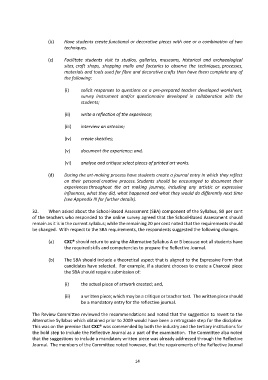Page 1386 - SUBSEC October 2017_Neat
P. 1386
(b) Have students create functional or decorative pieces with one or a combination of two
techniques.
(c) Facilitate students visit to studios, galleries, museums, historical and archaeological
sites, craft shops, shopping malls and factories to observe the techniques, processes,
materials and tools used for fibre and decorative crafts then have them complete any of
the following:
(i) solicit responses to questions on a pre-prepared teacher developed worksheet,
survey instrument and/or questionnaire developed in collaboration with the
students;
(ii) write a reflection of the experience;
(iii) interview an artesian;
(iv) create sketches;
(v) document the experience; and,
(vi) analyse and critique select pieces of printed art works.
(d) During the art-making process have students create a journal entry in which they reflect
on their personal creative process. Students should be encouraged to document their
experiences throughout the art making journey, including any artistic or expressive
influences, what they did, what happened and what they would do differently next time
(see Appendix III for further details).
32. When asked about the School-Based Assessment (SBA) component of the Syllabus, 80 per cent
of the teachers who responded to the online survey agreed that the School-Based Assessment should
remain as it is in the current syllabus; while the remaining 20 per cent noted that the requirements should
be changed. With respect to the SBA requirements, the respondents suggested the following changes.
(a) CXC® should return to using the Alternative Syllabus A or B because not all students have
the required skills and competencies to prepare the Reflective Journal.
(b) The SBA should include a theoretical aspect that is aligned to the Expressive Form that
candidates have selected. For example, if a student chooses to create a Charcoal piece
the SBA should require submission of:
(i) the actual piece of artwork created; and,
(ii) a written piece; which may be a critique or teacher test. The written piece should
be a mandatory entry for the reflective journal.
The Review Committee reviewed the recommendations and noted that the suggestion to revert to the
Alternative Syllabus which obtained prior to 2009 would have been a retrograde step for the discipline.
This was on the premise that CXC® was commended by both the industry and the tertiary institutions for
the bold step to include the Reflective Journal as a part of the examination. The Committee also noted
that the suggestions to include a mandatory written piece was already addressed through the Reflective
Journal. The members of the Committee noted however, that the requirements of the Reflective Journal
14

